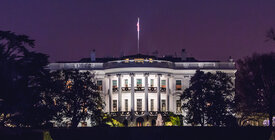
Courts Have Been Hiding Behind National Security for Too Long
Racial and religious minorities have suffered from judicial deference to post-9/11 claims of national security.

Part of
This essay is part of the Brennan Center’s series exploring new approaches to national security 20 years after 9/11.
In 2018, the Supreme Court upheld the Trump administration’s infamous travel ban excluding citizens from several predominantly Muslim countries. For two years, Donald Trump had demonstrated profound religious animus against Muslims, promising to impose a “complete shutdown” on Muslim immigration and praising stories of shooting Muslims with bullets dipped in pig’s blood. Despite the striking evidence of religious bias, the Court sustained the ban because the government offered a facially neutral explanation for the policy. The Court emphasized that its “inquiry into matters of entry and national security is highly constrained” and that the executive’s factual judgments on national security matters deserved deference.
Although Trump’s overt hostility toward Muslims made the travel ban notorious, Trump v. Hawaii fits within a larger pattern of courts deferring to executive branch claims of national security — claims that reached a fever pitch in the years after 9/11. During the George W. Bush administration, legal commentators celebrated the Supreme Court’s initial willingness to curb executive power in Guantánamo detainee cases from Hamdi v. Rumsfeld to Boumediene v. Bush. But the Supreme Court’s overall response to the 20-year “war on terror” reflects judicial abdication more than intervention. The result, in many cases, has been that victims of human rights violations receive no acknowledgment of harm, while security agencies remain unconstrained by legal precedent or the fear of judicial rebuke.
The core justifications for “national security deference” are unsound. Moreover, both the implications and origins of these ideas are racially fraught: the effects of national security deference fall largely on perceived racial and religious outsiders, while racial considerations shaped the very formation of the doctrines and help sustain them today. With the Supreme Court ideologically committed to national security deference, reform will require congressional action and broader public pressure.
A pattern of deference
Not a single doctrine but a set of ideas, national security deference manifests in legal decisions that limit a court’s authority to hear a case or particular claims, reduce the legal standard of review for a claim, or defer to the executive’s conclusion on a factual question.
The first category includes what are often thought of as justiciability limitations. In Clapper v. Amnesty International USA, for example, the Supreme Court ruled that legal and human rights groups lacked standing to challenge an electronic surveillance program because they couldn’t show that the government would necessarily surveil them. Although the decision relied on standing doctrine that in theory applies in all cases, the national security posture of the case clearly affected the analysis. The Court noted that it had often refused to find standing when reviewing “actions of the political branches in the fields of intelligence gathering and foreign affairs,” and that the discovery of information required to prove standing would risk informing terrorists whether they were under surveillance.
In Ziglar v. Abbasi, the Supreme Court similarly refused to allow post-9/11 immigrant detainees to sue high-level government officials for damages for asserted constitutional violations. Among other reasons, the Court found that “special factors” weighed against recognizing an implied damages remedy where a legal challenge would require an “inquiry into sensitive issues of national security.”
In the second category, courts hear a case but apply a lenient standard of review because the case implicates national security (and often immigration or foreign affairs, as well). This category is exemplified by Hawaii v. Trump, where the Court refused to consider whether the government’s stated justification for the travel ban was the real reason, despite the litany of statements by Trump suggesting anti-Muslim animus. The decision suggested that, at least in the context of entry to the United States, even overt religious or racial hostility to a group of noncitizens would be ignored so long as federal agencies devised a plausible security pretext.
In the third category, courts claim to apply a conventional legal standard, but zealously defer to the government’s factual findings. Thus, in Holder v. Humanitarian Law Project, the Court upheld a statutory ban on providing material support to designated foreign terrorist organizations, even as applied to speech supporting their lawful activities, partly because it deferred to the government’s factual judgment that all contributions to terrorist groups facilitate their violence. The Court declared that judges lack the competence to second-guess determinations on evolving national security threats — an assertion that has since been frequently cited by lower courts.
The Court appears poised to further insulate national security activities from judicial scrutiny. It recently agreed to hear two cases in which the Ninth Circuit Court of Appeals partly rejected the government’s argument that the “state secrets” doctrine shielded security agencies or their contractors — the first involving a Guantánamo detainee’s legal challenge to CIA torture in a foreign court, and the second challenging FBI surveillance of Southern California Muslims. The state secrets doctrine originated as a basis for the government to protect particular information from disclosure in litigation, but in recent decades, it has transformed into a justification for courts to refuse to hear cases at all.
Across these decisions, courts often cite similar rationales for national security deference: the notion that foreign affairs or national security decisions are constitutionally allocated to the executive, the belief that politically accountable actors should decide high-stakes questions, the idea that courts lack expertise in the security arena, or the fear that adjudication could reveal national security secrets.
Legal scholars have vigorously challenged these ideas. Deborah Pearlstein, Robert Chesney, and Aziz Huq have drawn on organizational theory, social psychology, and political science to critique the idea that the executive branch has singular expertise in the national security arena. Others have argued that the justifications for exceptionalism neither apply to all foreign relations or national security cases nor categorically distinguish such cases from other areas. And I have argued that courts can address secrecy concerns through tailored procedural experimentation rather than broad deference.
The racial dimensions of national security deference
Beyond these reasons to question national security deference, the racial dimensions of deference present a powerful reason to challenge the concept. First, the effects of national security deference generally fall hardest on racial, ethnic, and religious communities who are most likely to be identified as security threats.
During World War II, the Supreme Court invoked deference to military judgments in upholding curfew and exclusion orders that led to the internment of over 110,000 Japanese Americans. Since 9/11, court decisions denying redress on national security grounds have most often affected Muslims, both within and beyond the United States.
While the Supreme Court once theorized that courts should apply greater scrutiny to cases involving minority communities facing prejudice — because political processes would least protect them — national security deference does the very opposite. It strips protection from the groups most likely to be stigmatized and least likely to be supported within majoritarian political processes.
The reason that national security deference especially harms racial or religious minorities is not that these groups happen to present the greatest threat. Rather, race has always shaped who we view as the “nation” to be protected, how we identify threats to security, and the policies we adopt at home and abroad. The Supreme Court used to state this explicitly. In the 1889 “Chinese Exclusion Case,” for instance, the Court advocated deference to the political judgment that non-white foreigners presented an inherent security threat: “If… the government of the United States …. considers the presence of foreigners of a different race in this country, who will not assimilate with us, to be dangerous to its peace and security, their exclusion is not to be stayed.”
In our own time, race explains to a significant degree why the United States developed disparate legal regimes for “international” and “domestic” terrorism — two categories of threats defined less by geography than by the identity and ideology of those suspected. Muslim Americans acting alone inside the United States are categorized as international terrorists if they merely share the beliefs of overseas terrorist groups, while white supremacists are considered “domestic terrorists” (when they are considered terrorists at all) despite associating with or belonging to organizations with widespread overseas presence. Race shapes the very category of people and issues that are defined as threats to national security — and therefore the category of cases that trigger judicial deference.
Second, national security deference not only disadvantages groups considered racial outsiders, but at least some of its intellectual and jurisprudential roots can be traced to racist impulses. Our modern national security state is usually considered to be the outgrowth of World War II and beliefs about U.S. vulnerability, security, and expertise that emerged at the time. But the origins of national security deference go back much further, to ideas on foreign affairs and immigration that emanated from a racist and nativist Supreme Court. Legal scholar Sarah Cleveland has argued that during the late 19th century, the Supreme Court developed the idea that the federal government has inherent powers over foreign affairs that are independent of any constitutional grant of authority and largely unconstrained by judicial review. She argued that the Court established this notion in three sets of cases in order to support U.S. efforts to exclude Asian immigrants (as in the “Chinese Exclusion Case”), dispossess Indian lands, and acquire territory abroad.
While the intellectual genealogy of national security deference renders it suspect, the idea retains support because of its continued application to racial others. When those who are detained, surveilled, or tortured are typically brown or black, Muslim, and often immigrants or foreigners, it is only too easy for judges to overestimate the danger from second-guessing security agencies and undervalue the harm of denying redress.
The racialized effects and origins of national security deference require its disarmament. The current Supreme Court, however, appears steadfastly committed to it. There is greater hope that lower courts can be convinced to interpret national security deference narrowly, and that, over time, Congress can be pushed to reform the state secrets privilege, expand civil remedies for government wrongdoing, and pass substantive reform of national security policies. This will not be an easy lift. But at a moment when racial justice movements have shifted public awareness, understanding the racial dimensions of national security deference might help lay the foundations for a longer-term transformation.
Shirin Sinnar is a Professor of Law and the John A. Wilson Faculty Scholar at Stanford Law School. Her scholarship focuses on the legal treatment of political violence, the procedural dimensions of civil rights litigation, and the role of institutions in protecting individual rights and democratic values in the national security context.
More from the 9/11 at 20 series
-
Reining in the President’s Sanctions Powers
Used widely since 9/11, the benefits of sanctions often don’t outweigh the full costs. -
Ending the Post-9/11 Forever Wars
Congress wrongly gave the president carte blanche to use military force, and we’re still paying the price. -
Replacing the Department of Homeland Security with Something Better
A mistake made in panic would be best fixed by starting over.




